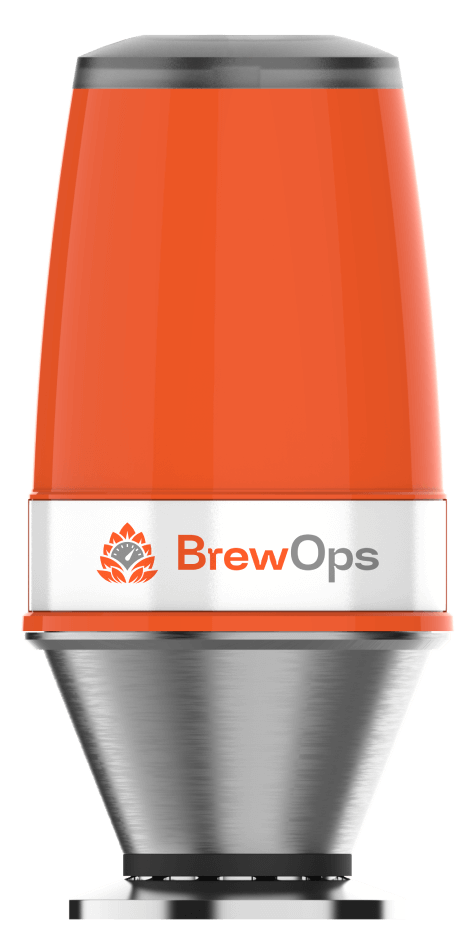Automated DO Measurement and Management Solution for Brewers
Dissolved oxygen (DO) plays a crucial role in a brewery, and its accurate measurement and control are essential for maintaining beer quality and consistency. Today, we’re discussing the uses of DO in a brewery, its importance, and how to best measure it using a high accuracy, zero maintenance solution.
In a brewery, the role of dissolved oxygen (DO) is paramount, impacting various stages of the brewing process to ensure the quality and characteristics of the final beer. DO measurement and management are crucial for achieving consistent flavor profiles, preventing oxidation, optimizing fermentation, and extending the shelf life of the product.
From fermentation control to packaging quality assurance, understanding and regulating DO levels are fundamental to producing high-quality beer that meets consumer expectations. Here, we explore the diverse uses of DO in a brewery, shedding light on its importance in maintaining the integrity and excellence of brewed beverages.
Four Main Uses of Dissolved Oxygen (DO) in a Brewery
- Fermentation Control
- Quality Control
- Packaging
- Process Optimization
1. Fermentation Control
Oxygen levels during fermentation are critical, which is why monitoring DO helps brewers maintain the right environment for yeast metabolism. Low oxygen ensures healthy yeast growth and minimizes off-flavors. Oxygen is a double-edged sword during fermentation, and its presence in the early stages can have a significant impact on yeast health and the resulting beer flavor. There are some specific aspects to consider and why it’s crucial to control it DO effectively, as we discuss here.
Yeast Health and Growth: Yeast requires oxygen during the initial stages of fermentation for healthy growth and reproduction. Adequate oxygen promotes a strong yeast population, ensuring efficient sugar consumption and alcohol production.
Oxygen Uptake and Ethanol Production: Yeast utilizes oxygen for its metabolic pathways, particularly aerobic respiration, during the lag and early exponential phases. As yeast consumes oxygen, it prepares for the anaerobic phase where it converts sugars to alcohol and carbon dioxide.
Avoiding Oxidative Stress: Excessive oxygen during fermentation can lead to oxidative stress for the yeast. This stress can result in the production of unwanted compounds and off-flavors in the beer.
Off-Flavor Prevention: High levels of DO can cause the yeast to produce undesirable flavors like acetic acid (vinegar-like), fatty acids, and other off-flavors, affecting the taste and aroma of the beer.
Fermentation Efficiency: Proper control of DO ensures a smooth transition from the aerobic phase to anaerobic fermentation, optimizing yeast performance and overall fermentation efficiency.
Consistency in Flavor and Quality: By managing and minimizing oxygen exposure during fermentation, brewers can maintain consistent flavor profiles, enhancing the quality and characteristics of the final product.
Extended Shelf Life: Controlling DO during fermentation contributes to a longer shelf life for the beer. Lower oxygen levels lead to reduced oxidation, preserving the beer’s quality and taste over time.
2. Quality Control
Oxygen affects the flavor, aroma, and shelf life of beer. Monitoring DO throughout the brewing process helps maintain product quality and consistency. Managing and minimizing DO levels at various stages of the brewing process is paramount to achieving consistent flavor profiles, extending shelf life, and ensuring the overall quality of the final product. Let’s take a closer look at how DO control impacts quality control in brewing. You’ll see some overlap here, but the subtleties are never lost on brewer, who can taste (even smell or see) an off batch if it has occurred. They can sample or smell the beer during various phases of the brewing—from mashing, lautering, and boiling through the fermentation, maturation, carbonation, all the way through packaging. Of course, brew houses have technology to back-up their bloodhound sensibilities.
Preventing Oxidation: Controlling DO during brewing is vital in preventing oxidation, which can negatively impact the beer’s flavor, aroma, and shelf life. Oxidation can lead to off-flavors, such as a cardboard-like taste, which is undesirable in beer.
Consistent Flavor Profiles: Proper DO control ensures that the intended flavors and aromas of the beer are preserved and consistent from batch to batch. Excessive oxygen exposure can alter the beer’s taste and compromise its overall quality.
Minimizing Off-Flavors: Oxygen can lead to the production of off-flavors in beer, including acetic acid, aldehydes, and esters. Maintaining low DO levels helps minimize the occurrence of these off-flavors, ensuring a more appealing and enjoyable beer.
Enhancing Yeast Performance: Yeast health and performance are optimized when oxygen exposure is controlled. Too much oxygen can stress the yeast and negatively impact fermentation, affecting the beer’s quality. Proper DO management supports efficient yeast metabolism and fermentation.
Preserving Aroma and Freshness: Oxygen exposure can cause the loss of delicate hop aromas and other volatile compounds in beer. By minimizing DO, brewers can retain the beer’s aroma and overall freshness, contributing to a higher quality product.
Improving Shelf Life: Low DO levels result in a longer shelf life for the beer. Oxygen is a major factor in beer spoilage, and by managing its presence, brewers can extend the beer’s freshness and maintain its quality over an extended period.
Ensuring Packaging Quality: During packaging, minimizing DO in the headspace of bottles, cans, or kegs is critical to prevent further oxidation and maintain the quality of the product. Proper purging and sealing techniques are essential for packaging quality control.
Customer Satisfaction: Consistency in beer quality directly impacts customer satisfaction.
3. Packaging
Oxygen ingress during packaging is a significant concern for breweries, as it can lead to beer spoilage and impact the overall quality and flavor of the beer. Measuring DO in the packaged product ensures that it meets quality standards and has an extended shelf life. Oxygen is one of the primary enemies of beer, and its presence can cause a variety of issues, which we talk about further below.
Oxidation: Oxygen can react with the compounds in beer, leading to oxidation. Oxidation causes the degradation of flavors, aromas, and colors, resulting in a stale, cardboard-like taste and a darker appearance of the beer.
Off-Flavors and Aromas: Oxidation can produce off-flavors and off-odors in the beer, including a papery or musty taste and aroma. These off-flavors are considered undesirable and can significantly impact the beer’s quality and consumer appeal.
Reduced Shelf Life: Oxygen accelerates the aging process of beer. When oxygen is present in the packaging, it can cause the beer to deteriorate more quickly, reducing its shelf life and making it less desirable to consumers.
Faster Staling: Oxygen speeds up the staling of beer, causing it to lose its fresh taste and character at a faster rate. This affects the intended flavor profile and can result in beer that does not meet quality standards.
Microbial Growth: Oxygen can provide an environment conducive to the growth of spoilage microorganisms, such as acetobacter and lactic acid bacteria. These organisms can produce off-flavors, spoil the beer, and render it unfit for consumption.
Quality Variation: Ingressed oxygen can lead to inconsistent beer quality across batches. This variability makes it challenging to maintain a consistent product, impacting consumer
expectations and brand reputation.
Haze Formation: Oxygen can contribute to haze formation in beer, affecting its appearance and clarity. This is particularly relevant for beer styles that are expected to have good clarity.
To mitigate oxygen ingress during packaging and prevent beer spoilage, breweries take several measures, including:
Proper Sealing and Capping: Using appropriate sealing and capping techniques to minimize oxygen exposure and ensure an airtight seal on bottles, cans, or kegs.
Purging the Packaging: Purging the headspace in containers with inert gases like nitrogen or carbon dioxide to displace oxygen before sealing, reducing the risk of oxidation.
Optimizing Filling Processes: Implementing precise filling procedures to minimize splashing and agitation, which can introduce oxygen into the beer.
Monitoring Oxygen Levels: Regularly monitoring dissolved oxygen levels in packaged beer to ensure compliance with quality standards and take corrective actions if necessary.
4. Process Optimization
Dissolved Oxygen (DO) measurement is a critical tool that helps brewers optimize multiple stages of the brewing process, including transfers, filtration, and carbonation. Accurate monitoring of DO levels enables brewers to make informed decisions and adjustments to achieve the desired quality and characteristics in the final beer. Here’s how DO measurement aids in optimizing these stages.
Transfers: During transfers from one vessel to another (e.g., from fermenter to conditioning tank), minimizing oxygen exposure is crucial. Measuring DO before and after transfers allows brewers to assess the potential ingress of oxygen and identify if proper transfer procedures were followed to prevent oxidation. Monitoring DO at this stage helps in controlling the amount of oxygen that could negatively impact the beer’s quality.
Filtration: Filtration is a key step to clarify beer and remove unwanted particles. High DO levels can lead to oxidation during filtration, affecting the beer’s flavor and appearance. DO measurement before and after filtration ensures that the process is carried out with minimal oxygen exposure, preserving the beer’s quality and preventing off-flavors associated with oxidation.
Carbonation: Achieving the desired carbonation level in beer requires precise control of dissolved CO 2, which is closely related to DO levels. High DO can negatively impact carbonation by affecting the CO 2 equilibrium in the beer. By monitoring DO during carbonation, brewers can adjust carbonation techniques to maintain the intended CO 2 levels, ensuring consistent taste and mouthfeel across batches.
Aeration Processes: In specific beer styles, controlled aeration is intentional and essential, especially during brewing stages such as mashing or at the start of fermentation. However, excessive aeration can lead to high DO levels, resulting in unwanted oxidation. Measuring DO allows brewers to strike the right balance, ensuring that aeration is controlled and deliberate, aligning with the beer style and flavor goals.
Quality Assurance: Throughout the brewing process, including transfers, filtration, and carbonation, regular DO measurements are a part of quality assurance protocols. Brewers set target DO levels for each stage and monitor the actual levels against these targets. This proactive approach helps maintain product consistency, meet quality standards, and avoid potential issues related to oxidation.
DO Recap
Effective DO monitoring and control during fermentation are crucial for yeast health, efficient fermentation, and preventing off-flavors, ensuring high-quality beer that meets consumer expectations.
Maintaining optimal DO levels is fundamental for preserving desired flavors, aromas, and beer quality, leading to a satisfying consumer experience.
Additionally, addressing oxygen ingress during packaging is vital for maintaining beer quality, freshness, and shelf life. Incorporating DO measurement at critical brewing stages allows brewers to control oxygen exposure, manage carbonation levels, and optimize filtration and transfers, essential for producing beer that aligns with consumer preferences and ensures brewing success.
How Is Dissolved Oxygen Measured in a Beer?
DO in beer is typically measured using specialized equipment and methods designed to provide accurate and reliable results. There are several methods used to measure DO in beer production. There are two methods that the automated, real-time monitoring platform we provide, BrewOps DO, works with.
One method is called Henry’s Law. It is a fundamental principle in physical chemistry that describes the relationship between the partial pressure of a gas above a liquid and the concentration of that gas dissolved in the liquid. It states that at a constant temperature, the amount of a gas that dissolves into a liquid is directly proportional to the partial pressure of that gas in the gas phase.
A very common method for measuring dissolved oxygen in beer involves using an optical dissolved oxygen meter, also known as a DO meter or oxygen analyzer. Optical sensors are widely used in the brewing industry. They employ luminescent technology, which measures the luorescence of a dye that reacts with oxygen. This non-invasive method provides fast and accurate DO measurements and is suitable for both lab and production environments.
Measuring the partial pressure of oxygen (pO2) in beer is typically done using specialized equipment known as dissolved oxygen (DO) sensors or meters. These sensors are designed to quantify the amount of oxygen dissolved in the liquid, such as beer, by determining the partial pressure of oxygen in the gas phase in contact with the liquid.
Here’s a brief overview of how the process works:
Sensor Principle: DO sensors use various principles to measure dissolved oxygen. The most common types are optical sensors and electrochemical sensors.
Optical Sensors: Optical sensors use a fluorescent dye that changes its fluorescence properties based on the oxygen concentration. The change in fluorescence is directly related to the oxygen levels in the sample.
Electrochemical Sensors: Electrochemical sensors use a permeable membrane that allows oxygen molecules to diffuse into the sensor. The oxygen interacts with an electrode, creating an electrical current proportional to the oxygen concentration.
Calibration: Before use, the sensor is calibrated using a two-point calibration process: a zero-oxygen calibration (in nitrogen-purged water or nitrogen atmosphere) and a full-scale calibration (in air-saturated water).
Measurement: The sensor is then submerged in the beer sample, and the partial pressure of oxygen in the gas phase just above the liquid is measured. This measurement is converted into a dissolved oxygen concentration in the beer.
Data Display: The dissolved oxygen concentration is typically displayed in units such as parts per million (ppm) or milligrams per liter (mg/L). Brewers can monitor this data in real-time on the sensor display or through connected software.
Monitoring and Control: Brewers use these measurements to monitor and control the dissolved oxygen levels at different stages of the brewing process, ensuring the beer’s quality and consistency.
As noted, accurate and precise measurement of dissolved oxygen is vital in brewing to maintain beer quality, optimize fermentation, and enhance the beer’s shelf life. Breweries often invest in high-quality, well-calibrated DO measurement equipment to achieve the best results and produce high-quality beer.
BrewOps DO Monitoring
BrewOps helps brewers automate their brewing processes to save money and ensure quality products. This automation solutions platform is a comprehensive brewing operations management software—with a dedicated BrewOps DO application—that provides real-time monitoring, easy-to-read dashboards and alerts, historical data analysis, remote monitoring, data integrations and analytics, and reporting and documentation. Mobile-centric, it offers portable, battery-powered devices that provide wireless monitoring of every critical brew process, allowing for instant oversight and reliable real-time data.
What You Get with BrewOps DO
You’ll see results in real time, along with countless benefits to your beer, business, and bottom line. In fact, all of the calibration is stored in the sensor cap, so after it’s time to recalibrate, you simply swap to a new cap, scan a barcode with the BrewOps app, then you are done. The existing industry standard requires manual recalibration with buffer solutions, calibration gas, or that you send the probe out to a third party for a costly and time-consuming calibration, leaving you stranded in the meantime.
BrewOps DO is plug-and-play, 1/4 the cost of the competition, accurate, reliable, and maintenance free. As well, you benefit from:
- Reduced packaged oxygen
- Increased consistency in your finished product
- Filling station analytics
- Scalable platform that is portable, in-line, and easy to move
- Real-time temperature and dissolved oxygen (ppb level) monitoring
- Ability to visually track results from across the brewery, or with the BrewOps app
- Fast, easy installation, no wiring or tools required
- Rugged, sanitary construction, easy to clean
- Replaceable long-lasting battery
- Designed with brewers in mind
The ability to monitor and manage your DO in the most effective and efficient way available in the brewing industry is at your fingertips.



